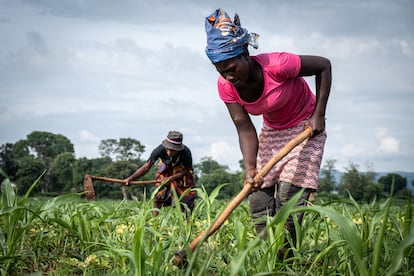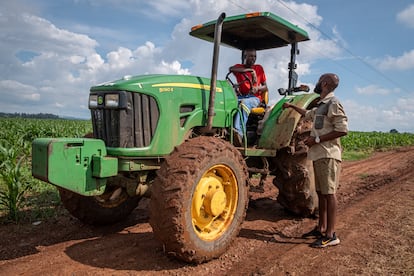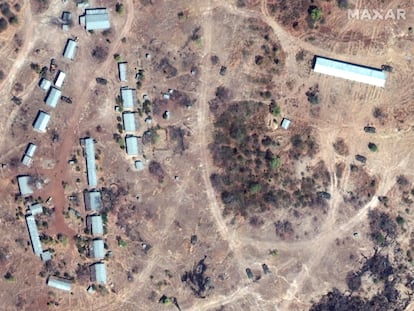Zimbabwe set for another record wheat yield, bringing back the dream of self-sufficiency
With the war in Ukraine as a wake-up call, the African country has decided to focus more on its own production and less on imports. But bigger harvests will not by themselves solve the problem of food insecurity

As soon as Tino Zinyemba steps out of his shiny SUV, the snow-white soles of his sneakers sink a few centimeters into the mud. But he doesn’t seem to mind that his Nikes get dirty: the drizzle in Glendale, a small farming village north of the capital, Harare, is a blessing for the crops on Zinyemba’s farm. While his “farm manager” gives him an update on how his lands are doing, Zinyemba’s gaze sweeps over the lush fields of lettuce and young corn plants.
The fields that are due for weeding today are looking green and lush. His lands are doing so well, in fact, that his yield might even be larger than last year. Just like many other farmers in Zimbabwe, Zinyemba is set to grow even more wheat than last year’s record yield. “Last year, we were able to grow 150 hectares full of wheat,” says Zinyemba with a satisfied smile on his face. “That’s a very good harvest.”
Continuing power cuts, hyperinflation and the aftermath of the coronavirus pandemic have not stopped him and thousands of other farmers in Zimbabwe from a national record harvest: never, since the country gained independence in 1980, had as much wheat been grown as in 2022. The Zimbabwean government announced that no less than 375,000 tons of wheat was harvested last year - 20,000 tons more than the country needs for its own consumption.
Although the Zimbabwean winter has just begun, another record wheat harvest is expected this year after farmers in the Southern African country planted wheat crops on 86,000 hectares of land, compared to 80,000 hectares last year. By planting so many wheat crops before the planting deadline of June 15, the nation is hoping to produce 420,000 tons of the cereal - much more than the record yield of 375,000 tons that was achieved last year.
Granary of Africa
With the record harvest last year and good outlook for this year, Zimbabwe is one step closer to self-sufficiency. Since independence in 1980, ending reliance on wheat imports has been a dream of the Zimbabwean government. When Robert Mugabe took office as the country’s first Black prime minister, that dream was still realistic: Zimbabwe, rich in fertile soil, was still growing so much wheat that the country came to be known as ‘the granary of Africa.’
But only after a long series of consecutive good harvests can the government speak of complete independence, something that was never possible under Mugabe’s rule. When the authoritarian leader decided in 2000 to divide all agricultural land (fields that were largely owned by white farmers) among Black Zimbabweans, production of wheat, tobacco and maize, among other things, plummeted. Much of the country soon decayed. Zimbabwe has still not recovered from the blow that the controversial land expropriations meant to the country’s economy.
“Mugabe didn’t want any other lenders than the government,” said Tafadzwa Musarara, head of the Flour Millers’ Association of Zimbabwe. “That was a big problem: many people were not farmers, but just farm owners.” When Emmerson Mnangagwa, the current president, came to power in 2017 to succeed Mugabe (he belongs to Mugabe’s Zanu PF party), he knew that the restrictive policy of his predecessor had to be overturned.
While wheat production has plummeted in recent decades, demand has only increased, Musarara said. His association represents the processing companies that buy the wheat from the farmers. “Zimbabwe is experiencing heavy urbanization,” he explains. “Many are leaving the countryside for the city.” In rural areas, Zimbabweans traditionally eat maize, sorghum and rice. In the big cities, however – due to globalization and the adoption of Western eating patterns – Zimbabweans increasingly eat bread and cereals.
In addition, the population of the country continues to grow. In the year 2000 the demand for wheat was still 200,000 tons, a number that by now has almost doubled. Until recently, this meant that Zimbabwe had to import $300 million worth of wheat, including from South Africa, Latvia and Poland. But Zimbabwe obtained the lion’s share of wheat from Russia and Ukraine. Due to Putin’s invasion of Ukraine and the sanctions against Russia that followed, the supply of wheat was interrupted for so long that the price of wheat rose sharply last year.
In 2020, 15 African countries imported over 50% of their wheat from Ukraine and Russia, according to the United Nations. The African Development Bank (AFDB) notes that the Russian invasion of Ukraine led to a shortage of some 30 million tons of grain on the continent, along with a sharp increase in price. President Mnangagwa said that the war in Ukraine should therefore be a “wake-up call” for African countries: he says it is high time that they start growing their own food.
Self-sufficiency
The surplus of last year and the prospect for an even larger surplus this year has allowed Zimbabwe to openly dream of food self-sufficiency again. Additionally, last year’s saved $300 million in wheat imports became part of Zimbabwe’s gross domestic product, rather than disappearing abroad, notes Agriculture Ministry Permanent Secretary John Basera.
According to Basera, the recent success story shows that Zimbabwe can become 100 percent wheat self-sufficient, but Musarara points out that still specific types of wheat must be imported, even when there is a surplus. “We bake our bread with European machines,” he explains, “and we still need high-quality wheat to get the tasty and nutritious bread that you can also buy in Europe. We’ve gotten used to that now.” Musarara also doesn’t think Zimbabwe will be self-sufficient any time soon. “Only when you have a surplus for ten years,” he says, “are you truly self-sufficient. Only then will there be enough reserves to deal with unexpected events such as a war in Ukraine or a pandemic, for example.”
Big words and self-congratulation notwithstanding, last year’s surplus doesn’t mean that Zimbabwe is much closer to solving poignant issues like food insecurity and extreme poverty. According to the World Food Programme of the United Nations, at least 49% of the population lives in extreme poverty. Frequent droughts have significant consequences on livelihoods and food security, WFP reports, with about 70% of the population dependent on rain-fed farming. According to additional numbers, 30% of the rural population was cereal insecure at the start of the lean season (October to December 2022), while 38% (3.8 million) was cereal insecure during the peak (January to March 2023).

To become wheat self-sufficient and to get rid of high import costs, the Zimbabwean government introduced schemes to boost its own agricultural production even before the war in Ukraine started. For example, through government programs, farmers can borrow agricultural machinery to grow crops. For obtaining some of the machines and agricultural knowledge, President Mnangagwa received support from the controversial president of Belarus, Aleksandr Lukashenko – in part because few other international investors dare to invest in Zimbabwean agriculture.
“We owe our record harvest to our collaboration with the private sector,” says John Basera, permanent secretary of the Ministry of Agriculture. He sees that companies and investors, at the initiative of the government, have invested on a large scale in joint ventures. They not only do this to earn money, says Basera, “but certainly also to guarantee food security in our country”. The joint ventures between the business community and the agricultural sector are now bearing fruit for the first time, says Basera, who refers to the historic wheat surplus.
One of the lenders who decided to invest in agricultural land due to the new arrangements is the young Tino Zinyemba. The child of a wealthy farming couple, he initially wanted nothing to do with farming – he studied computer science and worked as a consultant for a consultancy firm in Harare. Yet the peasant’s blood crept where it can’t go. Now he not only ensures that his parents’ fields are farmed, but that crops are also grown on nearby pieces of land. He has no regrets about switching to his parents’ sector: last year’s good harvests and the high turnover that came with it makes him hungry for more. And so Zinyemba, along with other investors, hunts overgrown plots of land, hoping to add the land to his farms.
Because of the new legislation, more and more white farmers are returning to Zimbabwe, although government officials are not keen to talk about this. It is difficult for many of these farmers to buy back their lost land, Musarara notes. “That is why they now want to invest in the farms that used to be theirs. That is groundbreaking, unparalleled and historic.” They often work with the Black owners to restart production on their land. “White capital”, the association representative calls it. And it has its positive points, for example, the transfer of knowledge. But it also increases competition between Black and white investors.
This afternoon, the young entrepreneur from Harare is out again with his rather muddy all-terrain vehicle. He has his eye on a faded field near Glendale that he hopes to add to his collection of farms. “I often don’t even know how I’m going to make it financially yet,” says the entrepreneur - a smile is visible again in his groomed beard. “But when an opportunity arises, I’ll take it with both hands.”
Sign up for our weekly newsletter to get more English-language news coverage from EL PAÍS USA Edition
Tu suscripción se está usando en otro dispositivo
¿Quieres añadir otro usuario a tu suscripción?
Si continúas leyendo en este dispositivo, no se podrá leer en el otro.
FlechaTu suscripción se está usando en otro dispositivo y solo puedes acceder a EL PAÍS desde un dispositivo a la vez.
Si quieres compartir tu cuenta, cambia tu suscripción a la modalidad Premium, así podrás añadir otro usuario. Cada uno accederá con su propia cuenta de email, lo que os permitirá personalizar vuestra experiencia en EL PAÍS.
¿Tienes una suscripción de empresa? Accede aquí para contratar más cuentas.
En el caso de no saber quién está usando tu cuenta, te recomendamos cambiar tu contraseña aquí.
Si decides continuar compartiendo tu cuenta, este mensaje se mostrará en tu dispositivo y en el de la otra persona que está usando tu cuenta de forma indefinida, afectando a tu experiencia de lectura. Puedes consultar aquí los términos y condiciones de la suscripción digital.
More information
Archived In
Últimas noticias
The metaverse, four years later: Is it finished or just at a standstill?
$3,000 and a plane ticket: The United States increases incentives for migrants to self-deport before the end of the year
Charles Dubouloz, mountaineering star, retires at 36 with a farewell tour inspired by Walter Bonatti
From the White House to diplomatic gifts: Lego wins over adult fans, brick by brick
Most viewed
- The low-cost creative revolution: How technology is making art accessible to everyone
- Christian Louboutin: ‘Young people don’t want to be like their parents. And if their parents wear sneakers, they’re going to look for something else’
- All the effects of gentrification in one corner of Mexico’s Colonia Roma
- Liset Menéndez de la Prida, neuroscientist: ‘It’s not normal to constantly seek pleasure; it’s important to be bored, to be calm’
- Christmas loses its festive spirit: ICE fears cast shadow over religious celebrations









































